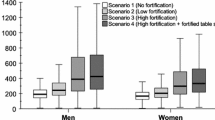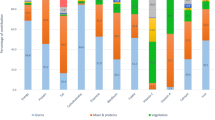Abstract
Objective
To assess intake of folate/folic acid and food sources in Japanese female dietitians.
Subjects and Methods
We evaluated folate consumption based on four season 7 consecutive day weighed diet records (WDRs) provided by 80 Japanese female dietitians and compared the results with data from a national survey. We then selected informative foods for folate intake on the basis of 2,240 WDRs according to contribution and multiple regression analyses.
Results
Daily folate consumption (mean±SD) among Japanese dietitians was 413±158 μg from raw foods and 343±128 μg from cooked foods. Average residual rate after cooking was 84±8%. Folate intake in summer was lower than that in other seasons by analysis of variance. According to contribution and multiple regression analyses, the major contributors were vegetables, fruit and green tea.
Conclusions
Daily folate intake among Japanese female dietitians was far greater than the 200 μg recommended daily allowance for the Japanese. Irrespective of selection methods and raw/cooked foods, major folate sources were found to be green tea along with vegetables and fruit.
Similar content being viewed by others
References
Murray RK, Granner DK, Mayes PA, Rodwell VW. Harper’s Biochemistry. 25th ed. Stamford: Appleton & Lange, 2000.
Scholl TO, Johnson WG. Folic acid: influence on the outcome of pregnancy. Am. J. Clin. Nutr. 2000; 71(suppl): S1295-S1303.
Refsum H. Folute, vitamin B12 and homocysteine in relation to birth defects and pregnancy outcome. Br. J. Nutr. 2001; 85(suppl):S109-S113.
Brattström L, Wilcken DEL. Homocysteine and cardiovascular disease: cause or effect? Am. J. Clin. Nutr. 2000; 72: 315–323.
Ueland PM, Refsum H, Beresford SAA, Vollset SE. The controversy over homocysteine and cardiovascular risk. Am. J. Clin. Nutr. 2000; 72: 324–332.
Rogers AE. Methyl donors in the diet and responses to chemical carcinogens. Am. J. Clin. Nutr. 1995; 61(suppl): S659-S665.
Choi S-W, Mason JB. Folate and carcinogenesis: an integrated scheme. J. Nutr. 2000; 130: 129–132.
Food Nutrition Board. National Research Council. Recommended Dietary Allowances. 10th ed. Washington DC: National Academy Press, 1989.
Her Majesty’s Stationary Office. Report on Health Social Subjects. Dietary Reference Values for Food and Energy and Nutrients for the United Kingdom. London: Her Majesty’s Stationary Office. 1991.
International Centre for Birth Defects. Annual Report 2000. Rome: International Clearinghouse for Birth Defects Monitoring Systems, 2001.
Committee for Risk Reduction of Birth Defects (Chairman: Hirayama M). Report on Risk Reduction of Neural Tube Defects. Tokyo: Ministry of Health and Welfare, 2000. (in Japanese)
Ministry of Health, Labor and Welfare. Nutrition Status Based on the National Nutrition Survey in 1998. Tokyo: Daiichi-Shuppan. 2000. (in Japanese)
Science and Technology Agency. Standard Tables of Food Composition. 5th Revised ed. Tokyo: Governmental Printing Office, 2000. (in Japanese)
Nygård O, Refsum H, Ueland PM, Stensvold I, Nortrehaug JE, Kvåle G, Vollset SE. Coffee consumption and plasma total homocysteine: the Hordaland Homocysteine Study. Am. J. Clin. Nutr. 1997; 65: 136–143.
Koehler KM, Pareo-Tubbeh SL, Romero LJ, Baumgartner RN. Garry PJ. Folate nutrition and older adults: challenges and opportunities. J. Am. Diet. Assoc. 1997; 97: 167–173.
Subar AF, Block G, James LD. Folate intake and food sources in the US population. Am. J. Clin. Nutr. 1989; 50: 508–516.
Rasmussen LB, Ovesen L, Bülow I, Knudsen N, Laurberg P, Perrild H. Folate intake, lifestyle factors, and homocysteine concentrations in younger and older women. Am. J. Clin. Nutr. 2000; 72: 1156–1163.
de Bree A, Verschuren WMM, Blom HJ, Kromhout D. Lifestyle factors and plasma homocysteine concentrations in a general population sample. Am. J. Epidemiol. 2001; 154: 150–154.
Konings EJM, Roomans HHS, Dorant E, Goldbohm RA, Saris WHM, van den Brandt PA. Folate intake of the Dutch population according to newly established liquid chromatography data for foods. Am. J. Clin. Nutr. 2001; 73: 765–776.
Mayer Jr O, Ŝimon J, Rosolová H. A population study of the influence of beer consumption on folate and homocysteine concentrations. Eur. J. Clin. Nutr. 2001; 55: 605–609.
Hiraoka M, Yasuda K. Studies on vitamin B12 and folate status in female students—distribution ranges of serum vitamin B12 and folate levels— Vitamin (Japan) 2000; 74: 271–280. (in Japanese)
Tokudome S, Ikeda M, Tokudome Y, Imaeda N, Kitagawa I, Fujiwara N. Development of data-based semi-quantitative food frequency questionnaire for dietary studies in middle-aged Japanese. Jpn. J. Clin. Oncol. 1998; 28: 679–687.
Tokudome S, Imaeda N, Tokudome Y, Fujiwara N, Nagaya T, Sato J, Kuriki K, Ikeda M, Maki S. Relative validity of a semiquantitative food frequency questionnaire versus 28 day weighed diet records in Japanese female dietitians. Eur. J. Clin. Nutr. 2001; 55: 735–742.
Imaeda N, Tokudome Y, Fujiwara N, Nagaya T, Kamae M, Tsunekawa S, Sato N, Tokizane M, Koide Y, Miyai Y, Maki S, Tokudome S. Data checking and standardization in a weighed food dietary record survey. Jpn. J. Nutr. 2000; 58: 67–76. (in Japanese)
Block G, Dresser CM, Hartman AM, Carroll MD. Nutrient sources in the American diet: quantitative data from the NHANES II survey. I. Vitamins and minerals. Am. J. Epidemiol. 1985; 122: 13–26.
Stryker WS, Salvini S, Stampfer MJ, Sampson L, Colditz GA, Willett WC. Contributions of specific foods to absolute intake and between-person variation of nutrient consumption. J. Am. Diet. Assoc. 1991; 91: 172–178.
Mark SD, Thomas DG, Decarli A. Measurement of exposure to nutrients: an approach to the selection of informative foods. Am. J. Epidemiol. 1996; 143: 514–521.
Ministry of Health, Labor and Welfare. Dietary Allowances for the Japanese. 6th ed. Tokyo: Daiichi-Shuppan, 1999. (in Japanese)
Imaeda N, Fujiwara N, Tokudome Y, Ikeda M, Kuriki K, Nagaya T, Sato J, Goto C, Maki S, Tokudome S. Reproducibility of a semi-quantitative food frequency questionnaire in Japanese female dietitians. J. Epidemiol. 2002; 12: 45–53.
Tokudome S, Kuriki K, Moore MA. Seaweed and cancer prevention. Jpn. J. Cancer Res. 2001; 92: 1008–1009.
Kono S, Ikeda M, Tokudome S, Kuratsune M. A case-control study of gastric cancer and diet in northern Kyushu, Japan. Jpn. J. Cancer. Res. 1988; 79: 1067–1074.
Yu GP, Hsieh CC. Risk factors for stomach cancer: a population-based case-control study in Shanghai. Cancer Causes Control 1991; 2: 169–174.
Gao YT, McLaughlin JK, Blot WJ, Ji BT, Dai Q, Fraumeni Jr JF. Reduced risk of esophageal cancer associated with green tea consumption. J. Natl. Cancer Inst. 1994; 86: 855–858.
Kohlmeier L, Waterings KGC, Steck S, Kok FJ. Tea and cancer prevention: an evaluation of the epidemiologic literature. Nutr. Cancer. 1997; 27: 1–13.
World Cancer Research Fund/American Institute for Cancer Research. Food, Nutrition and the Prevention of Cancer: a Global Perspective. Washington DC: World Cancer Research Fund/American Institute for Cancer Research, 1997.
Bushman JL. Green tea and cancer in humans: a review of the literature. Nutr. Cancer 1998; 31: 151–159.
Author information
Authors and Affiliations
Corresponding author
Rights and permissions
About this article
Cite this article
Imaeda, N., Goto, C., Tokudome, Y. et al. Folate intake and food sources in Japanese female dietitians. Environ Health Prev Med 7, 156–161 (2002). https://doi.org/10.1007/BF02897944
Received:
Accepted:
Issue Date:
DOI: https://doi.org/10.1007/BF02897944




